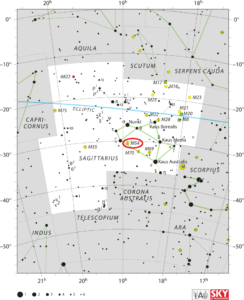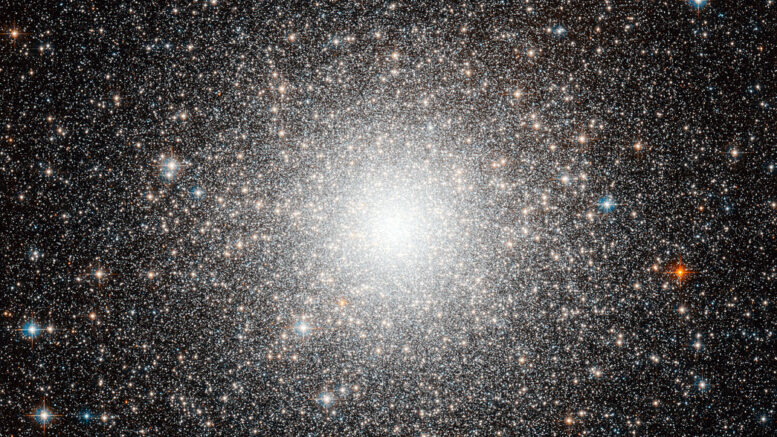Messier 54 was the first globular cluster discovered to belong to a different galaxy. It was originally thought to lie at a distance of 50,000 to 65,000 light years from the solar system and be one of the many globulars within the Milky Way. Messier 54 is the furthest Messier object located from Earth.
| Description | |
| Visible From Pacific Northwest | June To September |
| Best Time To Observe | June, July and August |
| Minimum Size Of Viewing Device | Medium Sized Telescopes |
| Object Type | Globular Cluster |
| Designations | Messier 54, M54, NGC 6715, GCl 104, C 1851-305, MWSC 3023 |
| Right Ascension | 18h 55m 03.33s |
| Declination | -30°28’47.5” |
| Constellation | Sagittarius |
| Number Of Stars | More Than 1 Million |
| Apparent magnitude | +8.37 |
| Apparent dimensions | 12′ |
| Object Radius | 153 light years |
| Distance From Earth | 87,400 light years |
History
Messier 54 was discovered by Charles Messier on July 24, 1778. Messier included the object in his catalogue with the following description: “Very faint nebula, discovered in Sagittarius; its center is brilliant & it contains no star, seen with an achromatic telescope of 3.5 feet [FL]. Its position has been determined from Zeta Sagittarii, of 3rd magnitude.”
William Herschel was able to resolve the cluster’s outer regions into individual 14th and 15th magnitude stars.
In 1994 scientists discovered that M54 most likely belonged to the Sagittarius Dwarf Elliptical Galaxy (SagDEG), one of the satellite galaxies of the Milky Way that will eventually be captured and eaten by our galaxy.
In 2009, astronomers discovered evidence of an intermediate-mass black hole in the centre of the cluster. It was the first object of its kind ever detected in a globular cluster. The black hole has an estimated mass of 9,400 solar masses.
Locating M54 In The Sky
Messier 54 is very easy to find as it lies near Ascella, Zeta Sagittarii, the third brightest star in Sagittarius and one of the stars that form the celestial Teapot. The cluster is positioned 0.5 degrees south and 1.5 degrees west of the star.

Viewing M54
While M54 is easy to locate, even large amateur telescopes cannot resolve it into individual stars, and binoculars and small telescopes reveal only a round, hazy patch of light. The best time of year to observe the cluster is during the months of June, July and August, but it never rises high above horizon for northern observers.
Photographing M54
Globular clusters are honestly low hanging fruit if you have a quality refractor Short exposures are the best option for globular clusters for imaging as short exposures will not saturate the star cores and it is far easier to preserve the star colors both in the cluster itself and in the surrounding sky. It is worth noting that globular clusters are less affected by moonlight than other Deep Sky objects.
It will be important to utilize accurate autoguiding to make sure that the stars in the open cluster remain crisp. It is recommended to utilize Luminance, Red, Green, and Blue filters for accurate image capture. The larger the telescope the better. There aren’t many great guides to help those looking for tips, but forums such as cloudy nights and astrobin provide great ways to look at the work that others have done with the same gear. This can allow one to infer what options are available to them.
Sources And Further Reading
Descriptions of all of Messier Objects can be found here.
https://www.nasa.gov/feature/goddard/2017/messier-54
https://www.messier.seds.org/m/m054.html
https://freestarcharts.com/messier-54


Be the first to comment on "Messier 54"